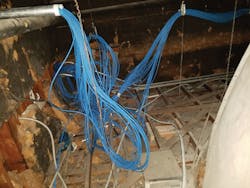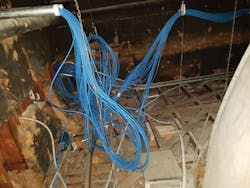Textbook cabling "What not to do"
We have a standing joke at the Cabling Installation & Maintenance editorial desk about the internet meme-like notion of “What not to do” as a recurrent pet phraseology for defining a range of maladroit behaviors-but especially within the cabling trade. Check out CablingInstall.com’s homepage “Must-See Photos” gallery to thumb through voluminous examples of the phrase, pictorialized. A good many of these photos have been sent in by readers. On this page is another.
Robert R., an IT project manager with a large California school district, found this unpleasant surprise. His commentary: “This is an ongoing problem. We are constantly having to correct these issues. Every time we fix one, another one pops up.”
This mess was left by techs either ignorant or ambivalent to the concept of “the plenum”-what it means, what it implies, what it defines for a specific space in the building. From Wikipedia.com: “Space between the structural ceiling and the dropped ceiling or under a raised floor is typically considered plenum.” This shot was apparently taken within an extremely aged drop ceiling space. To paraphrase a line from a famous movie, if this ain’t plenum, it’ll do till the plenum gets here.
A big question: Is any of the structured cabling abandoned, or is it just poorly looped and bundled, installed on the well-known premise of, “Always put in too much” … and forget about cable management? And what about those power lines snaking by and through? Ever hear of the standard warning against placing data cables against sources of electrical interference?
Conscientious techs know that cables, especially those with PoE, can overheat in large bundles, and need to be kept cool, because changes in cables’ thermal properties can affect the electrical performance and impact signal propagation.
But back on the note of abandoned cabling, again from Wikipedia: “The cavity/plenum space is typically used to house the communication cables for the building’s computer and telephone network; however, it has been proposed that the growing abandonment of cable in plenum spaces may pose a serious hazard in the event of a fire, as once the fire reaches the plenum space, the airflow present in the space supplies fresh oxygen to the flame and makes it grow much stronger than it would have otherwise been.”
This isn’t rocket science. Whatever the explanation, the case can be made that what we’re really looking at here is no more or less than a robust potential fire hazard and connectivity slough. How ironic that it’s from a school: a textbook, not to say classic, example of structured cabling “What not to do ..."

